Queen Elizabeth II dead: Monarch left her mark on Australian sport’s greatest events and triumphs
During a Royal tour in 1970, Queen Elizabeth and the royals were a star attraction at a VFL game. Five players involved on that day remember being starstruck by her majesty.
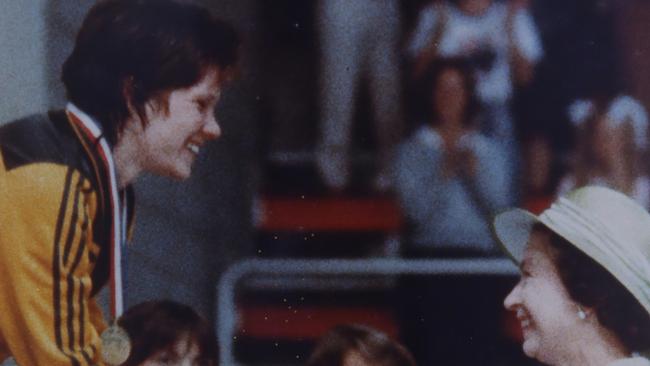
Sport
Don't miss out on the headlines from Sport. Followed categories will be added to My News.
On April 5, 1970, reigning premiers VFL premier Richmond played host to Fitzroy at the MCG in front of 38,617 and four royals — Queen Elizabeth, Prince Phillip, Princess Anne and Prince Charles.
It was the first VFL game to be played on a Sunday, moved to fit in with the royal tour.
Lions’ president, the late Ern Joseph, introduced his starstruck players to the Queen at halftime before his team produced a 20-point upset.
In 2007, we interviewed five members of that Fitzroy team about that momentous day.
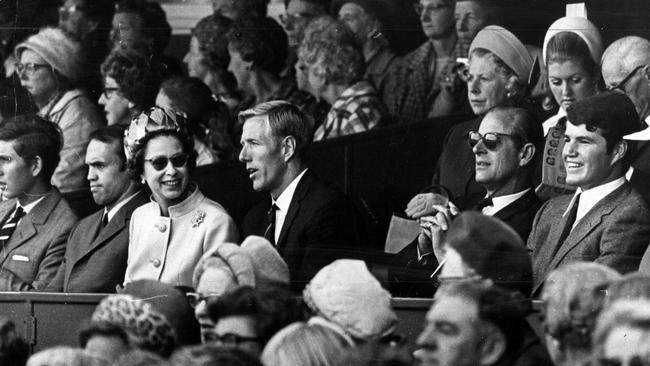
JOHN MURPHY
The father of Carlton’s Marc, Murphy played 216 games with Fitzroy from 1967-77, winning five club best and fairests and being named centreman in the club’s Team of the Century.
“Before meeting the Queen we had to wash our hands and faces at halftime, comb our hair and put our teeth back in. We chucked all our false teeth in a bucket and it took the trainers ages to work out whose were whose. I’m not sure if they made ‘Muzza’ (Kevin Murray) put a long sleeve jumper on to cover up his tatts.”
1 BARRY PADLEY
Blessed with a smooth kicking style, Padley played 159 games from 1967-78 after being recruited from Reservoir-Lakeside.
“I remember there was some hoo-haa from people saying why should the reigning premiers in Richmond have to play lowly Fitzroy in the opening game. We ended up beating Richmond twice that year. We were told not to speak to the royal family unless spoken to, just to shake hands.”
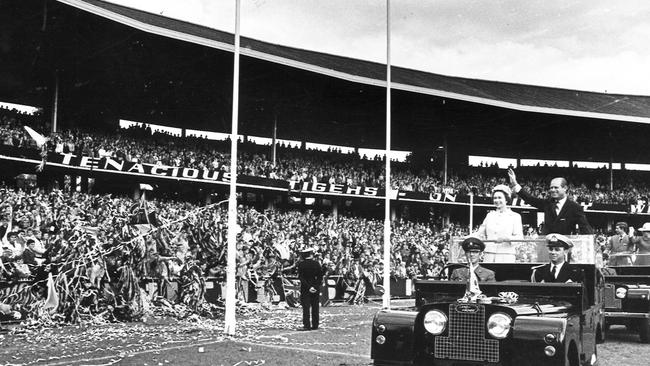
2 DARYL HERROD
An Assumption College product, red-headed halfback Herrod played 47 games with the Lions after playing seven with Geelong.
“We were told to clean up but I said, ‘Bugger that, I’m not worried about royalty, I want to win the bloody game’. I had a dirty old bandage on the hand I shook with. I played half-back, either on John Northey or Roger Dean. Say Dean because Northey kicked three. The best thing about it was winning for our coach Bill Stephen who was a great man and great coach. I’ve got the photo at home and it’s something to treasure for the kids.”
3 MIKE ANDREWS
From Wodonga, Andrews played 80 games as a centreman/defender from 1966-72.
“I spoke to the Queen to tell her I was British born (Gloucestershire). She asked what was I doing playing a game like this. I remember how beautiful her skin was. In fact she was a very good type. It’s the match I remember most, a game where our centre-line of Norm Dare, me and Graeme Shearer lined up on Bourke, Barrot, Clay. It’s funny you’ve rung because my wife and daughter gave me a framed photo of this day for Christmas.”

4 BILL SYKES
From Benalla, Sykes played 48 games from 1969-71 before coaching Benalla in the Ovens and Murray FL.
“Being a royalist, it was the highlight of my career. I was studying vet science at Melbourne Uni and living at a campus at Werribee. After Northey kicked three on me I went back to the Uni picnic races where my contemporaries were trying to catch field mice at the racetrack. Most of them didn’t believe I’d just met the Queen and her family. I think they thought I was having a kick locally somewhere. We didn’t get to play in front of big crowds very often.”
5 ALAN THOMPSON
Recruited from South Warrnambool, Thompson played 138 games as a wingman from 1970-79.
“I was petrified because it was my first game. I watched Hawthorn-Geelong at Glenferrie the day before and told my brother I wasn’t good enough. But I got a few kicks playing on a forward flank on Geoff Strang (Thompson kicked two). I remember noticing how beautifully polished the royals’ shoes were. I went to Buckingham Palace two years ago but the Queen didn’t come out. She must have forgotten me which was disappointing.”
HOW QUEEN LEFT HER MARK ON AUSTRALIAN SPORT
Julian Linden
As an avid sports lover, Queen Elizabeth never lost whenever Australia and England clashed on the field or the court or the track or the pool.
Bound to impartiality, the Queen always had a foot in both camps, so never let on who she was secretly barracking for.
Which is probably just as well at least for her British subjects, because during the course of her 70-year reign, her majesty presided over some of the most famous celebrations in Australian sport – often at the expense of the English.
The Queen presented so many major sporting prizes to Aussie athletes after she ascended the throne in 1952 that some just abandoned all the royal protocols and looked at her as part of the green and gold team.
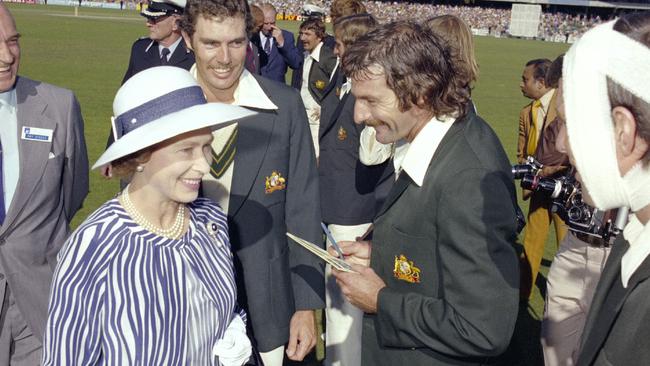
When cricket legend Dennis Lillee was introduced to the Queen before the 1977 Centenary Test, he cheekily asked her for an autograph. She declined at the time, but later sent him a personalised signed photo of their encounter.
“The picture takes pride of place in my house,” Lillee wrote in his autobiography.
“You can imagine how chuffed I was. I had probably embarrassed her and all the cricket officials but, at the time, I could not see the reason not to ask.”
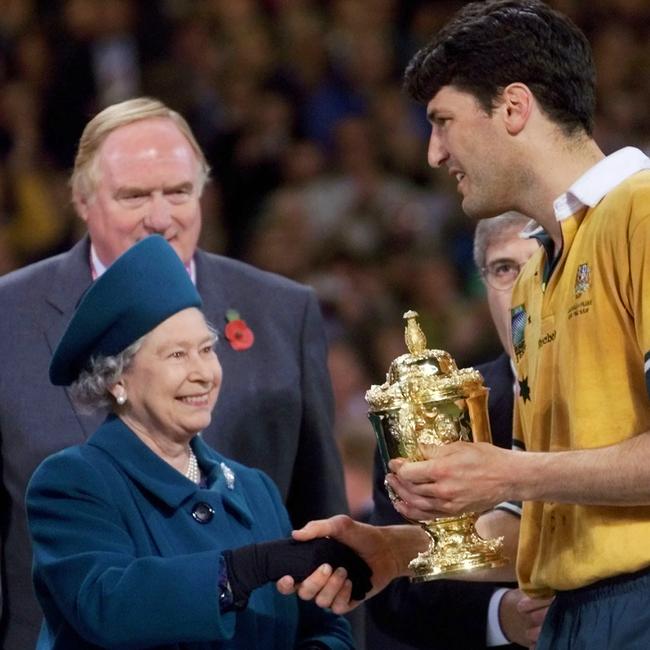
When Wallabies superstar halfback Nick Farr-Jones met the Queen for the first time at Buckingham Palace in 1984 he was told not to ask her any questions, but ignored the instructions.
“I thought ‘bugger that’. I was young and inquisitive so I asked her about what it was like being in London during the second World War and she was happy to talk about it,” Farr-Jones.
Farr-Jones met the Queen four times, including at the 1991 Rugby World Cup final at Twickenham in London, when the Wallabies played England.
When he was introducing his teammates to the Queen before the match, prop Dan Crowley handed the monarch a plastic XXXX footy, which he’d hidden behind his back. She politely accepted his gift.
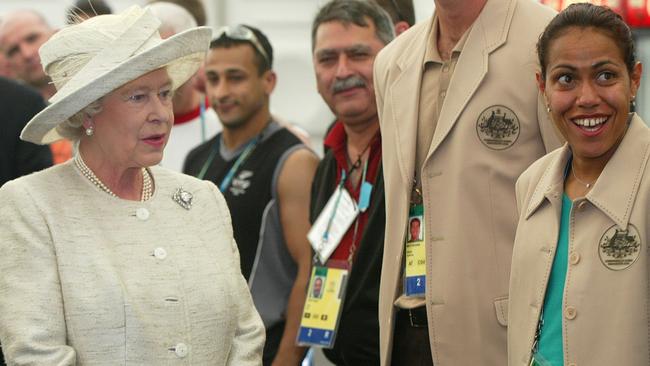
Late in the match, the Australian coach Bob Dwyer, sitting within earshot of the royal family, was left blushing when he briefly forgot where he was and fired out a few salty instructions to his players.
“We were defending a small lead and the backs were mucking around with the ball, so he screamed out, ‘kick it to the shithouse’, Farr-Jones recalled.
Australia held on to win 12-6 so the Queen presented Farr-Jones with the Webb Ellis Cup in what still remains one of the most enduring images of Australian sport.
“What I love about that photo is that we‘d just beaten England and you’d probably think she was cheering for England more than Australia, even though she’s our Queen as well,” he said.
“But just the beaming smile that she had when she greeted our team and handed me the World Cup, I cherish that so much because it‘s such a beautiful smile.
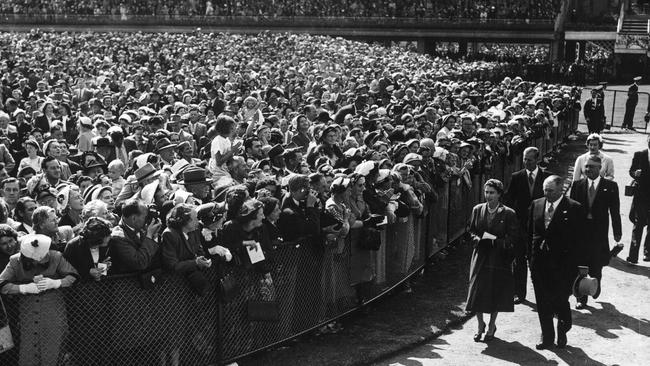
“She was such a rock in people‘s lives. I’ve heard a few people describe her as everyone’s grandmother.”
Eight years later, the Queen presented the same gold trophy to the Wallabies again, this time to John Eales, after Australia beat France in the 1999 World Cup final in Cardiff.
“That coincided with the day of the referendum, whether we wanted to become a republic or not, so that was interesting,” Eales said.
“It was certainly a very special moment in my career. She just said congratulations and was very gracious. She did so many extraordinary things in her life, so for her to be there at that moment was quite amazing.”
Eales also played in the 1991 final, and like Farr-Jones, he also got an invite to Buckingham Palace for tea with the Queen so was saddened by the news of her passing.
“She‘s been part of our lives for as long as I can remember. We’ve certainly respected her and the role that she has held and the place that role has had in history,” he said.
“We used to see her every day because she was on the coins we used to catch the bus to school and so on and she became so much a part of your life.
“So it is momentous when someone passes that has been so present in different ways across your life.”
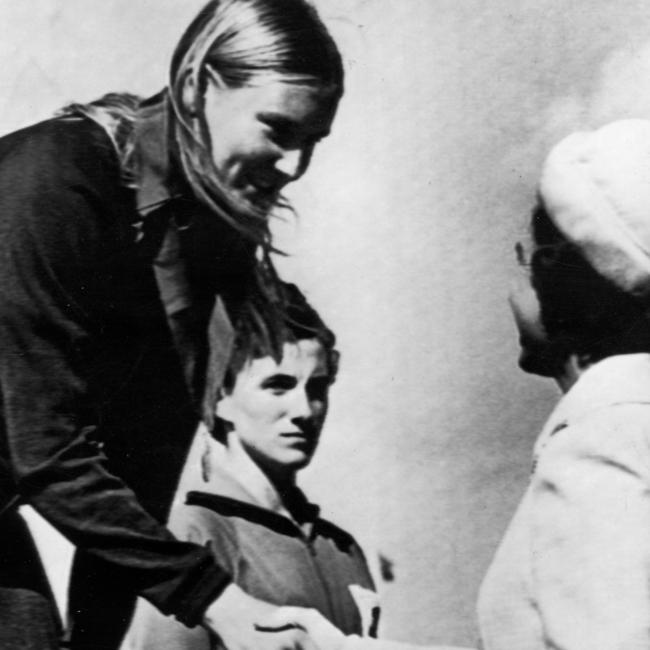
Australian tennis champion Rod Laver posted a tribute to the Queen on his social media account, including a photo of when she presented him with the Wimbledon’s singles title in 1962 – the same year he won the coveted grand slam for the first time.
Rocket wasn’t alone because there are so many great Australian athletes from a wide variety of sports that got to meet the Queen in person.
My deepest condolences to the Royal Family and the people of the United Kingdom at this sad time. Rest in Peace Your Majesty. pic.twitter.com/PTiaIhmPqp
— Rod Laver (@rodlaver) September 8, 2022
The only sport she ever did let it be known who she was cheering for was horse racing.
When the Queen made her first trip to Australia in 1954, she went straight to the races and frequently visited the track on her return visits.
She was also a regular at the Commonwealth Games and one of the most poignant moments of her connections to Australia was at the 1982 edition in Brisbane when she presented swimming legend Tracey Wickham with the gold medal after her win in the 400m freestyle.
Wickham had already decided she was retiring after the Commonwealth Games but was feeling so ill before the race she planned to pull out and only swam it when she was told by her coach Laurie Lawrence at the last minute that the Queen had hand picked that one race to present the medals.
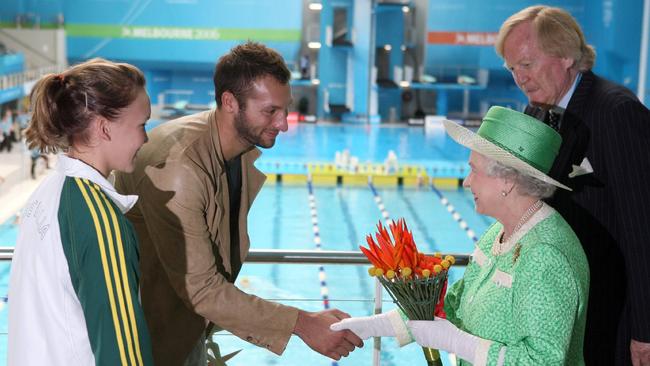
“To be presented with a gold medal from the Queen at the Commonwealth Games was just like the icing on the cake for me, the cherry on top. It was just a wonderful experience,” Wickham said.
“She said ‘well done for your swim, congratulations, you did so well’.
“All I could think of to say was ‘thank you so much ma’am. I really appreciate it.’
“Then she put the medal around my neck, and I shook her hand with both of my hands. She was just so warm, so genuine, she had a sense of humour and a beautiful heart. It‘s so sad she’s left us.”
That black and white photograph of Wickham receiving her gold medal from the Queen has become a national moment to treasure – 40 years since Brisbane hosted the Commonwealth Games and 10 years before the Queensland capital hosts the 2032 Olympics.
Wickham had kept a framed copy of the moment, which held pride of place among all her memorabilia, but it was stolen from her home and never returned.
“I’ve had a few things stolen from me over the years but that was special,” she said.
“I’ve been thinking about that moment a lot today so it’s sad I don’t have the photo any more because it’s sitting in someone else’s pool room.”




